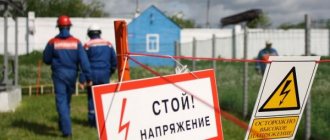Carrying out electrical work is a rather complex and dangerous procedure. Therefore, when performing such work, it is important to have the skills and experience to prevent emergency situations, violations of work technology and errors that can harm a person. Training, testing of knowledge in the field of electrical safety and obtaining an appropriate certificate by enterprise employees is a prerequisite for starting work, both for electrical and non-electrical personnel.
Categories of personnel in electrical safety
The main categories into which personnel are divided to obtain permission to work with electrical installations are:
- Electrotechnical;
- Electrotechnological;
- Not electrical.
Electrotechnological - personnel of production departments that work on electrical devices (electric ovens, electric welding, electrolysis and others), the work of which requires constant maintenance and adjustment of electrical equipment, electric drives, hand-held electrical machines, portable and mobile power receivers, portable power tools.
Non-electrical workers include workers whose activities involve interacting with various household appliances, simple electrical equipment and office equipment. Such workers are assigned electrical safety group I or II.
According to clause 1.4.1 of the PTEEP, the operation of electrical installations must be carried out by trained electrical personnel of the enterprise, who are divided into categories:
- administrative and technical;
- repair;
- operational;
- operational repair.
Administrative and technical
Specialists who organize the work process and manage the installation, configuration, maintenance and operation of electrical equipment.
Repair
Responsible for maintenance and repair of equipment, performs commissioning and commissioning.
Operational
Workers inspecting and monitoring electrical equipment perform prompt switching on, off, and switching of various electrical equipment in electrical installations. Responsible for permission to work in electrical installations.
Operational and repair
Personnel who monitor, maintain and repair electrical equipment that is assigned to this group;
Where do they rent for groups?
The exam for admission groups 2-5 takes place in the Rostechnadzor division that conducts training and certification of employees.
Training is carried out in the direction of the enterprise, in which it is necessary to indicate:
- employee position;
- his length of service in this position;
- required level of clearance.
Some organizations have their own permanent commission. She accepts exams and submits a draft order for the assignment (or upgrade) of qualifications to management for consideration. The commission must include:
- Chairman with electrical safety approval 5 (at voltages above (up to) 1000 V) and 4 (at voltages less than 1000 V). This is the person responsible for the electrical part;
- vice-chairman;
- secretary;
- at least 3 commission members.
After completing the training program and successfully passing the exam, employees are assigned categories of electrical engineering personnel (from 2 to 5). The corresponding mark is made in the certificate, the form of which is presented in Appendix No. 3 to the rules on labor protection during the operation of electrical installations, approved by Order of the Ministry of Labor of the Russian Federation dated July 24, 2013 No. 328n. The certificate is valid until the position changes.
What and how many electrical safety groups are there?
In accordance with the PTEEP on electrical safety, five qualification groups are assigned for personnel interacting with and servicing electrical equipment.
Group I is established for non-electrical personnel who, in their activities, use power tools and equipment that do not require special training to work with them. This group is assigned to an employee of an enterprise who has at least electrical safety group III and higher.
Group II is assigned to workers servicing electrical devices and working on them. These include lifting machine operators, electric welders, and other specialists whose work involves the use and maintenance of portable electrical equipment employed on the territory of the enterprise. This group is also established for newly hired electrical personnel (electricians and others).
Group III is established for electrical personnel working in networks with voltages up to 1000 V and over 1000 V. Personnel with this group are allowed to independently service electrical installations and equipment, including its inspection, connection and disconnection.
Group IV is assigned to a person from among the engineering and technical workers who is responsible for electrical facilities up to 1000 V at the enterprise. Also, this group can be assigned to operational electrical personnel for training newly hired workers or those with little experience.
Group V is established for specialists (engineering engineers) who are responsible in the organization for electrical equipment over 1000 V. They can also supervise the production of electrical installation work and work on equipment up to 1000 V.
Requirements
To a hand-held insulated tool
The tool includes the following elements:
- screwdrivers;
- pliers;
- pliers;
- wire cutters;
- keys;
- assembler's knives.
- made of conductive material, wholly or partially covered with insulating material;
- made of insulating material with metal inserts.
The purchased tool must be checked for compliance with the following requirements:
- the insulating layer must be permanent and made of durable, moisture-resistant material;
- the insulation of the screwdriver shaft should end no closer than 10 mm from the end of its tip;
- pliers, wire cutters and pliers on the handles must have stops of at least 5-10 mm;
- For assembly knives, the insulating handle must be at least 10 cm. On the side of the working part of the knife there must be a stop of at least 5 mm.
To dielectric gloves
Gloves can be seamless, with a seam, three-fingered or five-fingered. Their length should be about 350 mm, the size should allow gloves to be put on fabric mittens, and the width should allow them to be pulled over the sleeves of clothing.
To safety shoes
Special footwear includes boots and galoshes. Galoshes are used when working in networks up to 1000 V, and bots are used in any networks. Safety shoes should consist of a rubber upper, grooved sole and textile lining. Boots must be at least 160 mm high, and, in addition, they must have cuffs.
What you need to know about obtaining an electrical safety clearance group
Each electrical safety group requires specific knowledge, skills and experience to work on electrical installations. Therefore, in order to obtain an ES group and permission to work, you must undergo training and obtain permission to work. There is a certain procedure for assigning an electrical safety group to an employee.
Group I is assigned after undergoing instruction on the rules of working on electrical equipment and providing first aid in case of electric shock.
Group II requires workers to have special knowledge about the structure and operating principle of electrical equipment, safe work when working with power tools, as well as the consequences of electric shock and ways to provide assistance to victims of this phenomenon.
Group III is assigned only to electrical workers who have worked for 1 to 3 months at the enterprise. Such an employee must have knowledge of the design and principle of operation and maintenance of equipment, be able to monitor the progress of electrical work, be able to identify malfunctions and safety violations, and also provide assistance to victims of electric shock.
Group IV is received by specialists who have worked for 3 to 6 months with a confirmed III group and who have secondary vocational or higher education. This employee must be able to monitor and manage the production process, provide instructions, provide assistance, and also have serious knowledge in the field of maintenance, repair and operation of electrical installations for various purposes.
Group V is assigned to a specialist who has worked with Group IV from 3 months to two years, must know electrical installation diagrams, rules for using protective equipment and checking them, and operating rules for equipment. Also, an applicant for this group must be able to organize and manage work on electrical equipment with any voltage, be able to train personnel in labor safety rules, practical methods of providing first aid to victims at work, and be able to practically provide it.
Electrical category
It includes different job categories. Each has its own responsibilities.
| Type of personnel | Field of activity |
| Administrative (shop managers, chief engineers, etc.) | Responsible for planning and organizing work related to electrical equipment |
| Operational, repair, operational repair services | Perform work on switching, access to places of work, supervision. Subject to special training, they take part in eliminating the consequences of emergencies and malfunctions, and provide assistance to those engaged in repair work. |
| Specialized personnel (engineers, electricians, welders, electricians, etc.) | Perform direct work on electrical equipment |
Electrical safety clearance group for such employees: starting from 2 (is primary) and ending with 5 (allows independent work without restrictions).
How and where to take the exam
Group 5 on electrical safety: who is assigned electrical clearance, frequency
Non-electrical personnel are subject to inspection and training once a year. At the same time, the administrative and technical one can undergo inspection once every three years.
Personnel certification
Frequency of certification
Testing the level of knowledge on electronic security is carried out:
- Primary, that is, when hired or during a break between jobs for a period of three years.
- As planned. That is, according to a pre-established inspection plan.
- Unscheduled. When evaluating a previous inspection. Unscheduled inspections may be made in the event of the acquisition of new devices, the implementation of new mechanisms, according to the conclusion of the commission or control bodies.
Knowledge testing for the 1st group is carried out every year. If an employer allows a person who does not have certification to work, he will be charged with an administrative violation - up to 4 thousand rubles.
Important ! It is necessary to strictly follow the inspection schedule, without exaggerating the period, since if there is a long break between inspections, the group is lost (no matter what it is).
What documents are to be filled out?
During the briefing, in addition to the log, no other documents are filled out, and a certificate may not be issued.
How to obtain a Group 3 electrical safety certificate
People who have reached 18 years of age can enroll in courses and ultimately obtain qualifications of the third group of admission. Education for this level can be: high school, college, vocational school, technical school, university. A prerequisite is to have at least group 2 level.
Required experience in the “Electrical safety” competency from group 2 to group 3
| Education | Experience in months |
| General 9 classes (full-time employee) | 3 |
| Secondary full 11 classes (in the state) | 2 |
| Secondary technical (in the state) | 2 |
| Higher electrical engineering (in the state) | 1 |
| Internship after vocational school | 6 |
| Internship after technical school, college, university | 3 |
Distance learning courses
Since the equipment and electrical networks in the two categories of this qualification are different, the programs that can be mastered are also different. The information in them concerns certain installations with a solidly grounded or insulated neutral. However, the topics are identical.










